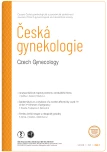Experiences in the reconstruction of untreated severe obstetrical injuries including anal sphincter injuries
Authors:
P. Hubka 1; M. Thiam 2; L. Gueye 2; Tomáš Brtnický 1
Authors‘ workplace:
Gynekologicko-porodnická klinika 1. LF UK a FN Bulovka, Praha
1; Service de Gynécologie-Obstétrique Centre Hospitalier Régional de Thiès, UFR des Sciences de la Santé, Université de Thiès, Thiès, Sénégal
2
Published in:
Ceska Gynekol 2023; 88(1): 52-55
Category:
Review Article
doi:
https://doi.org/10.48095/cccg202352
Overview
Objective: Summarize information on reconstruction possibilities of extensive obstetrical injuries including anal sphincter injuries. Methods: Review of available information on the possibilities of reconstruction of severe obstetrical injuries including anal sphincter and comparison with own results in the developing countries. Conclusion: Extensive obstetrical injuries of the perineum are major problem that require adequate and early treatment. In the developing countries, perineum dehiscence and the subsequent development of anal incontinence occur much more often. Even after several years, however, there is hope for an improvement in the condition if an adequate suture is performed.
Keywords:
obstetrics – faecal incontinence – anal sphincter
Sources
1. Sultan AH. Editorial: obstetrical perineal injury and anal incontinence. Clinical Risk 1999; 5 (6): 193–196. doi: 10.1177/135626229900500 601.
2. Fernando R, Sultan AH, Kettle C et al. Methods of repair for obstetric anal sphincter injury. Cochrane Database Syst Rev 2006; 3: CD002866. doi: 10.1002/14651858.CD002866. pub2.
3. Valbø A, Gjessing L, Herzog C et al. Anal sphincter tears at spontaneous delivery: a comparison of five hospitals in Norway. Acta Obstet Gynecol Scand 2008; 87 (11): 1176–1180. doi: 10.1080/00016340802460354.
4. Nordenstam J, Mellgren A, Altman D et al. Immediate or delayed repair of obstetric anal sphincter tears – a randomised controlled trial. BJOG 2008; 115 (7): 857–865. doi: 10.1111/j.1471-0528.2008.01726.x.
5. Gurol-Urganci I, Cromwell DA, Edozien LC et al. Third- and fourth-degree perineal tears among primiparous women in England between 2000 and 2012: time trends and risk factors. BJOG 2013; 120 (12): 1516–1525. doi: 10.1111/1471-0528.12363.
6. Fernando RJ, Sultan AH, Kettle C et al. Methods of repair for obstetric anal sphincter injury. Cochrane Database Syst Rev 2013; 12: CD002866. doi: 10.1002/14651858.CD002866.pub3.
7. Kleprlikova H, Kalis V, Lucovnik M et al. Manual perineal protection: the know‐how and the know‐why. Acta Obstet Gynecol Scand 2020; 99 (4): 445–450. doi: 10.1111/aogs.13781.
8. Jansova M, Kalis V, Rusavy Z et al. Fetal head size and effect of manual perineal protection. PLoS One 2017; 12 (12): e0189842. doi: 10.1371/journal.pone.0189842.
9. Kalis V, Karbanova J, Horak M et al. The incision angle of mediolateral episiotomy before delivery and after repair. Int J Gynaecol Obstet 2008; 103 (1): 5–8. doi: 10.1016/j.ijgo.2008.05.026.
10. Andrews V, Sultan AH, Thakar R et al. Risk factors for obstetric anal sphincter injury: a prospective study. Birth 2006; 33 (2): 117–122. doi: 10.1111/j.0730-7659.2006.00088.x.
11. RCOG. Third- and fourth-degree perineal tears, management (green-top guideline no. 29). 2015 [online]. Available from: https: //www.rcog.org.uk/en/guidelines-research-services/guidelines/gtg29/.
12. Kalis V, Bednarova B, Stepan J Jr et al. Repair of the 3rd and 4th degree obstetric perineal tear. Ceska Gynekol 2010; 75 (4): 284–291.
13. Okeahialam NA, Wong KW, Thakar R et al. The incidence of wound complications following primary repair of obstetric anal sphincter injuries: a systematic review and meta-analysis. Am J Obstet Gynecol 2022; 227 (2): 182–191. doi: 10.1016/j.ajog.2022.05.012.
14. Sule ST, Shittu SO. Puerperal complications of episiotomies at Ahmadu Bello University Teaching Hospital, Zaria, Nigeria. East Afr Med J 2004; 80 (7): 351–356. doi: 10.4314/eamj.v80i7.8717.
15. Goh J, Romanzi L, Elneil S et al. An International Continence Society (ICS) report on the terminology for female pelvic floor fistulas. Neurourol Urodyn 2020; 39 (8): 2040–2071. doi: 10.1002/nau.24508.
16. Vaizey CJ, Carapeti E, Cahill JA et al. Prospective comparison of faecal incontinence grading systems. Gut 1999; 44 (1): 77–80. doi: 10.1136/gut.44.1.77.
17. Parks AG, McPartlin JF. Late repair of injuries of the anal sphincter. Proc R Soc Med 1971; 64 (12): 1187–1189.
18. Dudding TC, Vaizey CJ, Kamm MA. Obstetric anal sphincter injury: incidence, risk factors, and management. Ann Surg 2008; 247 (2): 224–237. doi: 10.1097/SLA.0b013e318142cdf4.
19. Fernando RJ, Sultan AH, Radley S et al. Management of obstetric anal sphincter injury: a systematic review & national practice survey. BMC Health Serv Res 2002; 2 (1): 9. doi: 10.1186/1472-6963-2-9.
20. Hasegawa H, Yoshioka K, Keighley MR. Randomized trial of fecal diversion for sphincter repair. Dis Colon Rectum 2000; 43 (7): 961–964: discussion 964–965. doi: 10.1007/BF02237359.
21. Goh JT, Tan SB, Natukunda H et al. Outcomes following surgical repair using layered closure of unrepaired 4th degree perineal tear in rural western Uganda. Int Urogynecol J 2016; 27 (11): 1661–1666. doi: 10.1007/s00192-016-3024-6.
22. Hollingshead JR, Warusavitarne J, Vaizey CJ et al. Outcomes following repair of traumatic cloacal deformities. Br J Surg 2009; 96 (9): 1082–1085. doi: 10.1002/bjs.6664.
23. Goh JT, Natukunda H, Singasi I et al. Surgical repair and follow-up of chronic 4th degree obstetric perineal tear (total perineal defect) in 2 centres in eastern Africa. Int Urogynecol J 2021; 32 (9): 2437–2442. doi: 10.1007/s00192-021-04841-8.
Labels
Paediatric gynaecology Gynaecology and obstetrics Reproduction medicineArticle was published in
Czech Gynaecology

2023 Issue 1
Most read in this issue
- Cryopreservation of ovarian tissue as a method for fertility preservation in women
- Preterm premature rupture of membranes
- The fertility sparing therapy in ectopic pregnancy
- Traditional and contemporary views on the functional morphology of the fallopian tubes and their importance for gynecological practice
